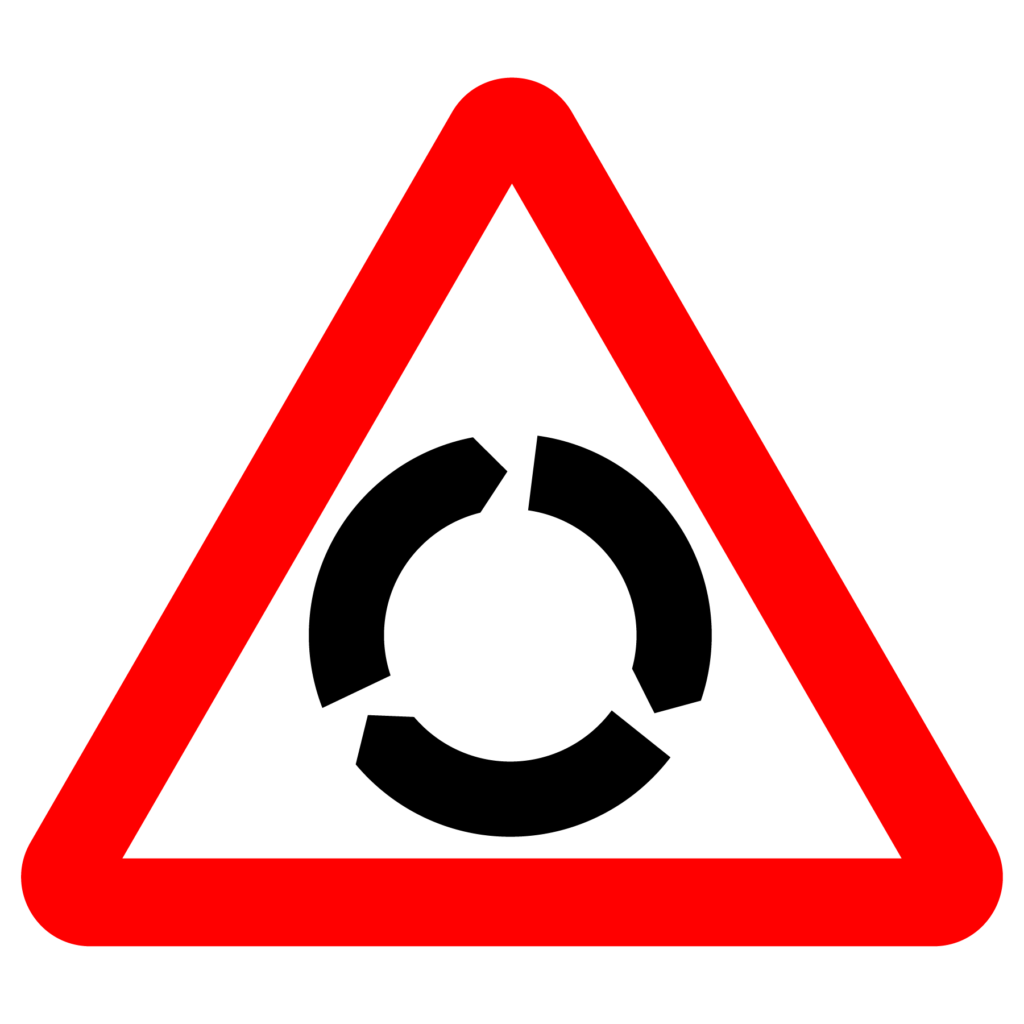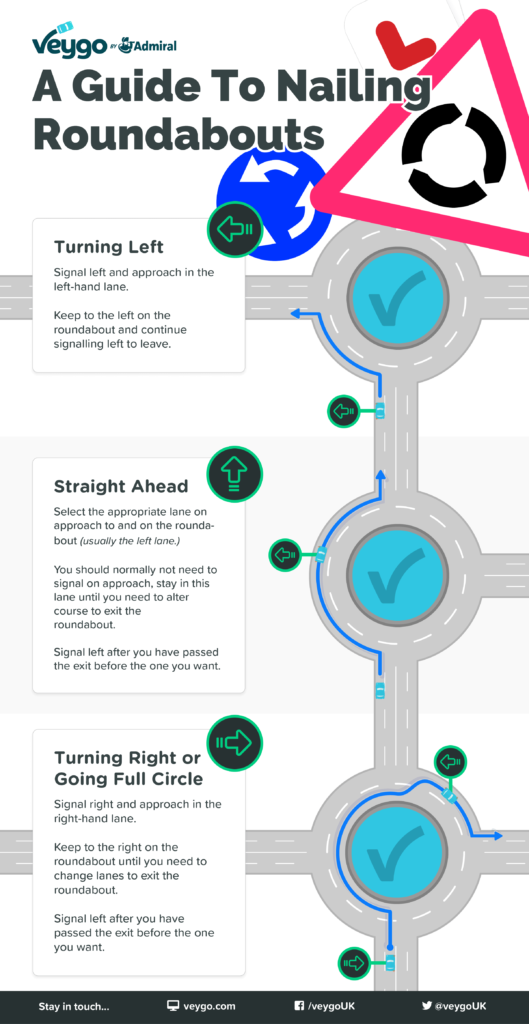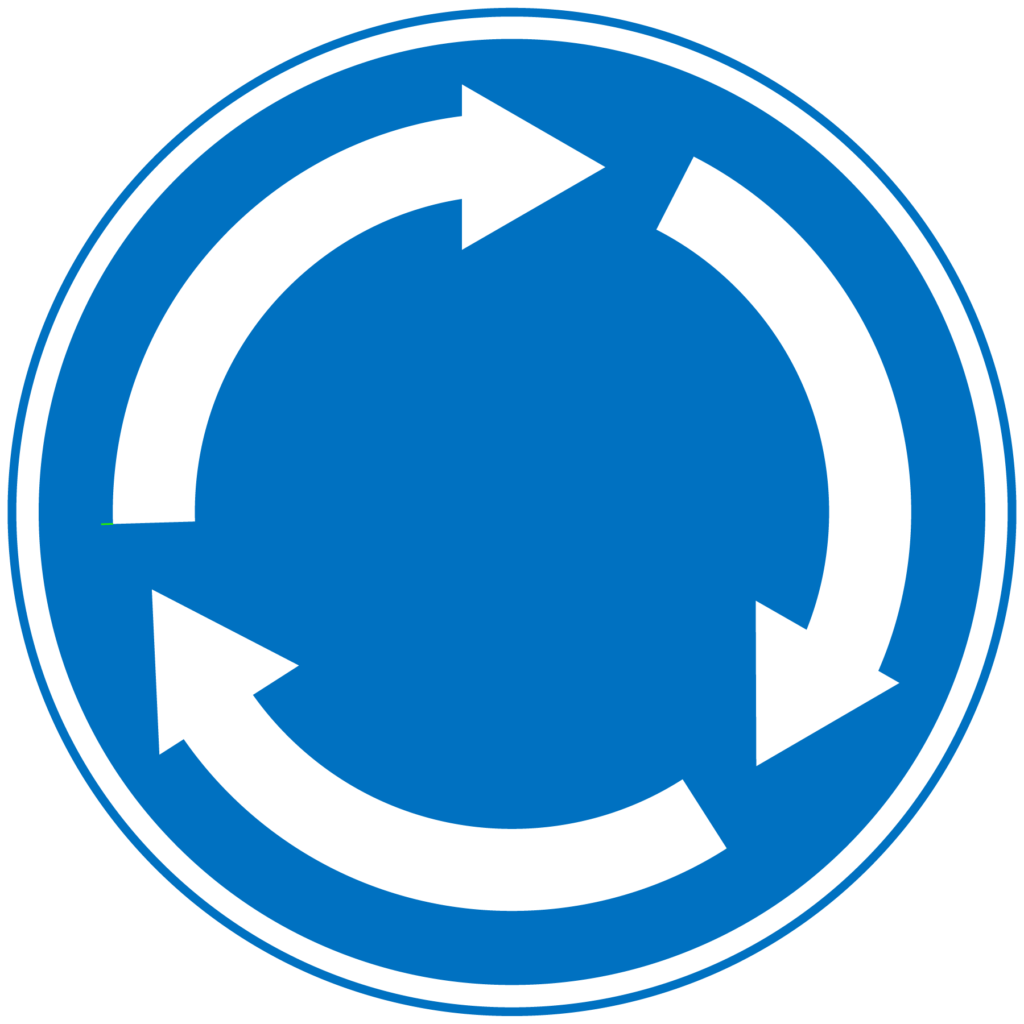Roundabouts. What can we say? Many learner drivers find roundabouts particularly difficult to get to grips with but however much you hate them, there’s no avoiding them. There are 10,000 roundabouts in the UK so you’re definitely going to face them during your driving lessons.
The Highway Code and roundabouts
Unless you live in or near Swindon, you probably won’t have to tackle the dreaded seven circle Magic Roundabout. However, even the single circle roundabouts can be confusing for beginners.
The driving test often involves challenging roundabouts in your local area. You might have to tackle anything from small mini roundabouts to big multi-lane roundabouts.
It’s important to understand what the rules are for roundabouts according to the Highway Code. Not to worry, here’s a guide to help you understand the rules of roundabout driving, which lane to take, when to signal and how to exit safely.
Roundabout sign
The roundabout sign is a red triangle warning with a circular symbol inside. That means it’s warning you that there’s a roundabout ahead.

Check out our guide to theory test road signs.
You’ll also see a rectangular sign that tells you where all of the exits head towards. It’s important to look out for this sign and get in the right lane for the exit you’re planning to take.
Who has the right of way in a roundabout?
According to the Highway Code, the only priority rule is that drivers inside the roundabout have the right-of-way over drivers entering the roundabout. So whenever you approach a roundabout, you need to give way to any drivers on the roundabout and wait for a clear path to enter.
How do I approach a roundabout?
Roundabouts are just a type of junction so you need to approach them in the same way. When there’s a roundabout ahead remember the MSPL routine, or Mirror, Signal, Position, Speed, Look.
Unlike other junctions, most roundabouts are quite open which allows you to assess the traffic flow and adjust your speed and if possible, enter the roundabout without stopping. Some drivers stop at the give way line when it isn’t necessary, so never assume the car in front of you will enter the roundabout, even when it’s clear.
Here is a diagram to show you the rules for approaching and exiting a standard closed roundabout from each angle.
Roundabout rules

Turning left at a roundabout
To turn left at a roundabout, make sure you signal left and approach in the left lane. Stay in the left lane and keep signalling until you have left the roundabout.
Going straight ahead at a roundabout
Select the appropriate lane on approach. Unless road markings indicate otherwise, you should use the left lane when going straight ahead. There’s no need to signal on approach. Make sure you stay in your lane as you go around the roundabout. When you’ve passed the exit before the one you need to take, signal left and exit.
Turning right at a roundabout
To turn right, make sure you approach in the right hand lane and signal right. Stay in your lane and signal left after passing the exit before the one you need to take. You may need to change lanes to leave the roundabout so make sure you complete the appropriate observations (Mirror-Signal-Manoeuvre).
Exiting roundabouts
You won’t fail your driving test by taking the incorrect exit, as long as you do so safely. The examiner is testing your driving ability, not navigation skills! However, you can fail your test if you forget to cancel your indicator after exiting the roundabout. Doing this can be confusing for other road users.
Watch out for pedestrian crossings! These are often placed just outside of roundabouts. This means there can be queues at the roundabout exit as people wait for pedestrians to cross. Make sure you look ahead to see if the exit you are taking is clear and so you can prepare for traffic if necessary, by ensuring you are in the correct lane.
What about mini roundabouts?
Mini roundabouts are also common in the UK, especially in residential areas. The same rules apply at roundabout of all sizes. However, it can be a bit confusing to know who’s got priority.
If there are no cars on the mini roundabout but cars approaching from different entrances, you should give way to traffic approaching from the right, unless directed otherwise by signs. Always keep a close eye on the driver before moving off to judge whether or not they’re giving way.
You may find that you’ll have to reduce your speed even further to navigate smaller roundabouts safely. You’ll need to pass around the central markings of mini roundabouts unless you’re driving (or towing) a vehicle which is too large to do so.
Mini roundabout sign
The mini roundabout sign is a blue circle with white arrows circling right. If you see a sign for a mini roundabout you should slow down.

For extra help or guidance when using roundabouts don’t forget to check out our YouTube video on roundabouts for beginners!
Roundabout Guide for Beginners - Common Roundabouts - Learn to Drive
Or if you’re further along into your learning to drive journey then why not check out our advanced tutorials!
Advanced Roundabouts - Box Junctions, Traffic Lights - Learn to Drive
If you’re learning to drive check out our guide on how to pass your driving test first time. Good luck!
Remember that practice makes perfect! If roundabouts make you nervous, try and get as much exposure before your driving test. If possible, get in some extra practice outside of lessons. We may be able to help you out with learner driver insurance. You could get cover from 2 hours up to 180 days and get as little or as much practice as you need!
